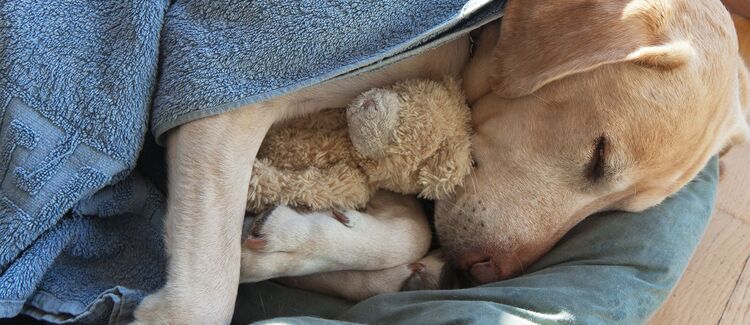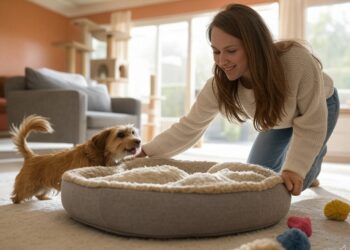Pets can enrich people’s lives with joy and affection. Significant studies demonstrate that having a furry companion at home may provide several health advantages and benefits for seniors or aging individuals. Moreover, pets may contribute to alleviating stress, anxiety, and sadness. And given all these benefits, it’s common for most fur parents to give nothing but the best to their beloved furry friends.
An example of this is providing your pets with a suitable environment for them to be in and a comfortable space where they can sleep. Much like you have your sleeping and living spaces, your furry companions should also have an area to relax and feel secure, especially during slumber.
And with that in mind, this article will outline some valuable insights and tips you can consider to help you build and maintain a secure, enjoyable, and pleasant resting area for your beloved furry friend.
Know-How Long Your Pet Sleeps
Before anything else, fur parents need to know and understand their pet’s sleeping patterns. While it’s true that dogs and cats sleep most of the time, their respective sleep-wake cycles may vary significantly. Domestication has paved the way for humans and dog rhythms to synchronize, and the same goes for cats. And be that as it may, being dusk and dawn animals, cats are often more active during certain hours of the day.
A healthy adult cat sleeps for 16 hours, whereas a dog sleeps approximately 12 hours. Throughout the day, pets take many brief naps. And, unlike humans, they can effortlessly fall asleep and quickly awaken when necessary.
Moreover, your pet’s age, health, and the environment in which they live all have a role in how much sleep they get. Young and old animals may sleep for up to 20 hours a day.
Understand The Importance Of Sleep For Pets
Good sleep is critical to the well-being of all individuals. It can help replenish your energy, strengthen your memories, and aid the development and repair of all of your bodily systems. And more so, scientists believe that animals, like humans, also need sleep for the same reasons.
Humans may become irritable, forgetful, and more vulnerable to sickness when they’re sleep-deprived. In the long term, it might even lead to death. For most animals, this is also the case. Previous studies showed that sleep-deprived animals tend to rapidly lose weight and get easily infected with diseases, which leads to eventual death. Thus, you may conclude that sleep and rest are indeed critical for the overall well-being of your beloved pets.
Reading Suggestion: Pitbull Chihuahua Mix Personality Trait, Puppies and Weight
Designate A Comfortable Space
Knowing how long your pet sleeps and how important a good sleep and rest for them is is only the beginning. Using this information can then allow you to designate and allot them a comfortable space to sleep in.
To start, your pet requires a relaxing and sleep-inducing environment of its own to be happy and healthy. When creating a comfy resting spot for your pet, consider a location in your house that receives little traffic. With their modest room, your pet may retreat to a calm and cozy area of your home at any time.
For dogs, their resting area doesn’t have to be enormous. As a matter of fact, most dogs prefer to sleep in smaller areas since they associate quiet, cozy, confined settings with their ancestral habitats. Additionally, putting them in a smaller space may help minimize undesirable habits such as chewing, whining, and accidents on the toilet. Moreover, almost any unoccupied area in your house may be converted into a dog’s sleeping area. Perhaps, a laundry room or even a large walk-in closet.
Cats, in comparison to dogs, are more flexible in where they choose to curl up to sleep. However, they are drawn to warm, calm, and secluded areas. So, providing your cat with a place to curl up and relax is a key component of building their perfect sleeping environment.
It’s also essential that your cat be comfortable and calm in its sleeping area. Thus, consider the location of your cat’s favorite sleeping or resting area. For instance, if your cat enjoys lounging on the window ledge, a window perch would be a good option. And much like dogs, cats also want secure, quiet areas to withdraw from home mayhem. So, consider placing your cat’s resting area in a less often visited room by relatives.
Buy Their Own Cozy Bed
Choosing a place for your pet to rest is an essential part of the process. But there are other things you can do to ensure that they get a good night’s rest. For instance, if you have a cat, you can get them a cat bed to sleep in. The same goes if you have a dog, you can also purchase a bed for them to lounge in.
A tip worth considering is that it’s beneficial for your pet to sleep on the same bed every night. Consistently sleeping in the same bed each night may assist pets in understanding when it is time to go to sleep. And while it may be nice to share your bed with them, it may negatively affect your sleep quality.
Some fur parents that have their pets sleeping next to them reported sleeping poorly. Notwithstanding the disturbances to sleep caused by movement and possibly barking, sleeping with your pet may also raise the risk of skin problems.
Reading Suggestion: Owl Legs – Everything That You Need to Know About The Mystery Animal
Likewise, it has negative consequences for individuals who suffer from asthma or allergies. Additionally, if you’re moving and flipping during the night, it can make it more difficult for your pet to sleep. Hence, providing a comfortable sleeping bed for your pet can be a critical aspect.
Pets, like humans, want a comfortable bed to sleep in. However, cats may be pretty particular in this regard. They’re likely to choose that old but soft blanket you despise over the lovely bed you’ve just purchased for them. But what matters most is that you provide them with a quiet, comfortable sleeping space away from the commotion.
Compared to cats, dogs want to cuddle close to their humans. However, it’s strongly advised that they have their own sleeping space. Having a designated area for your dog to lay down and relax in can serve as a secure haven for them. Additionally, it’s the most beneficial way for a restful night’s sleep.
A good bed for your pet must be firm, plush, and comfy. More so, it must support your pet’s body, particularly seniors, who experience joint pain or discomfort due to age-related diseases.
To help you, here are a few things to keep in mind when purchasing a pet bed:
Measure Your Pet
Measure your pet from the tip of the tail to the crown of the head using a tape measure. This dimension may be used to determine the right bed size for them. This can then be your guide before making a purchase.
A tip you can consider is to increase the size of the bed by a few inches to give allowance for your pet.
Make Sure The Bed Is Machine-washable
It’s essential to wash your pet’s bed regularly. By doing so, you’ll be able to eliminate hair and bacteria from their bed. Hence, look for a bed with a machine-washable cover.
Reading Suggestion: How Much Does It Cost to Dog Taxidermy?
Add Cozy Blankets
Covering the bed with blankets, towels, and even soft area rugs can help to provide your pet with a pleasant resting spot to enjoy throughout the day.
Moreover, it’s essential to maintain your pet’s bed and covers clean, just like you do with your bedding and blankets. In addition to making your pet feel more at home, keeping your pet’s bedding clean can lessen the likelihood that they may bring parasites into the house.
Ensure Your Pet’s Safety
Once you’ve picked a resting place and perfect cozy bed for your pet, it’s necessary to secure their environment. If your pet is old enough, you have to do nothing more than clean up. However, if you have a young, energetic, or restless puppy or kitten, you should take the following actions to pet-proof the surroundings:
- Items such as cleaning supplies and food should be kept in a separate room or stored high up behind locked cabinets.
- Electrical cables should be taped down or concealed beneath the furniture.
- Trash cans should be removed or replaced with pet-proof ones, such as a touch-free trash can.
- Remove shoes, clothes, children’s toys, and anything else you don’t want your pet to get into when you aren’t there to supervise.
- Set the thermostat in the room to a suitable temperature.
- Turn off any unneeded or potentially harmful space heaters while not in use.
It’s worth noting, too, that pets tend to dash from one location to another, which may cause damage to carpets over time. Hence, choose a flooring choice that is more durable and pet-safe. This can help avoid unwanted injury while also making cleanup simpler in the future.
In addition, you may install pet cameras to keep an eye on your beloved animals. Pet webcams are simple devices that allow you to monitor your pet while you’re away. Most of these tools are also budget-friendly. If you want to go all out, there are pet cams with built-in two-way audio that allow you to talk to your pet even if you’re away. Some even have a treat-tosser that allows you to reinforce excellent behavior remotely.
Add Some Furnishing Too
You may decorate a pet’s sleeping area in a variety of creative ways. But it depends on the kind of pets that will be staying. For instance, if you have cats, they will like scratching poles, feline trees, nooks, and a myriad of climbing and resting options.
Rugs can also be an excellent addition to their space. Rugs made of cotton, wool, and polyester are good options. It doesn’t take much to keep a pet happy. Moreover, when furnishing a pet’s resting area, style, comfort, and cleaning convenience are all key considerations.
Reading Suggestion: 5 Facts Worth Knowing About the Presa Canario Dog Breed
Leave Water For Your Pet
You may have read that it’s best to keep water out of your pet’s resting area. For the most part, this is because water dishes tend to topple into the sleeping area, making for a sloppy mess.
However, water is essential to your pet’s survival. Additionally, animals may get severely dehydrated in a matter of time. Hence, your pets should always have access to clean drinking water, as long as it doesn’t interfere with their toilet habits.
Your pets may drink from clip-on water bottles and bowls. Once you show them how to use a drink bottle, most pets will soon get the hang of it. If your pet is still having difficulty, try smearing some of their favorite food to the nozzle to encourage them to begin licking it. It may need a few attempts at first, but many pets rapidly pick it up after that.
Establish A Routine
Having the same routine every day can help train your pet when and where to rest for the night. For instance, if you routinely feed your pet several hours before bedtime, they can associate their eating habits with their sleep schedule and arrangement. While schedules may be a little more challenging to manage on weekends, strive to maintain a consistent routine.
Maintain a pleasant atmosphere in the hour before your pet rests. Stay away from overindulging them in treats and fun activities. Moreover, assure that your pet went to pee and poo before going to bed, so they will not need the toilet again in the wee hours.
Final Words
Nothing beats good sleep for relaxation and rejuvenation. This is true not just for humans but also for your four-legged family members. Most pets sleep about 12 to 18 hours a day. As such, they, like humans, need a comfortable place to rest.
As a fur parent, part of your responsibility is catering to your pet’s specific needs and requirements. And these include a comfortable place for them to sleep in. A decent space or even a pet bed can help your pet rest better and feel better overall. Moreover, allow your furry companion to curl up in luxury for a dreamy slumber by ensuring that their place is secure and comfortable.









